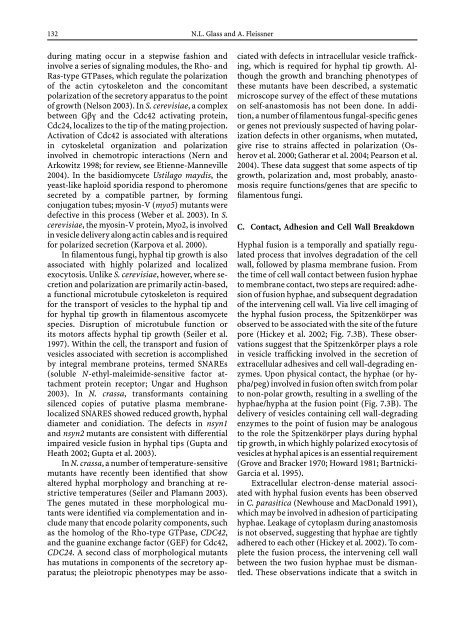Growth, Differentiation and Sexuality
Growth, Differentiation and Sexuality
Growth, Differentiation and Sexuality
Create successful ePaper yourself
Turn your PDF publications into a flip-book with our unique Google optimized e-Paper software.
132 N.L. Glass <strong>and</strong> A. Fleissner<br />
during mating occur in a stepwise fashion <strong>and</strong><br />
involve a series of signaling modules, the Rho- <strong>and</strong><br />
Ras-type GTPases, which regulate the polarization<br />
of the actin cytoskeleton <strong>and</strong> the concomitant<br />
polarization of the secretory apparatus to the point<br />
of growth (Nelson 2003). In S. cerevisiae,acomplex<br />
between Gβγ <strong>and</strong> the Cdc42 activating protein,<br />
Cdc24, localizes to the tip of the mating projection.<br />
Activation of Cdc42 is associated with alterations<br />
in cytoskeletal organization <strong>and</strong> polarization<br />
involved in chemotropic interactions (Nern <strong>and</strong><br />
Arkowitz 1998; for review, see Etienne-Manneville<br />
2004). In the basidiomycete Ustilago maydis, the<br />
yeast-like haploid sporidia respond to pheromone<br />
secreted by a compatible partner, by forming<br />
conjugation tubes; myosin-V (myo5) mutants were<br />
defective in this process (Weber et al. 2003). In S.<br />
cerevisiae, the myosin-V protein, Myo2, is involved<br />
in vesicle delivery along actin cables <strong>and</strong> is required<br />
for polarized secretion (Karpova et al. 2000).<br />
In filamentous fungi, hyphal tip growth is also<br />
associated with highly polarized <strong>and</strong> localized<br />
exocytosis. Unlike S. cerevisiae, however, where secretion<br />
<strong>and</strong> polarization are primarily actin-based,<br />
a functional microtubule cytoskeleton is required<br />
for the transport of vesicles to the hyphal tip <strong>and</strong><br />
for hyphal tip growth in filamentous ascomycete<br />
species. Disruption of microtubule function or<br />
its motors affects hyphal tip growth (Seiler et al.<br />
1997). Within the cell, the transport <strong>and</strong> fusion of<br />
vesicles associated with secretion is accomplished<br />
by integral membrane proteins, termed SNAREs<br />
(soluble N-ethyl-maleimide-sensitive factor attachment<br />
protein receptor; Ungar <strong>and</strong> Hughson<br />
2003). In N. crassa, transformants containing<br />
silenced copies of putative plasma membranelocalized<br />
SNARES showed reduced growth, hyphal<br />
diameter <strong>and</strong> conidiation. The defects in nsyn1<br />
<strong>and</strong> nsyn2 mutants are consistent with differential<br />
impaired vesicle fusion in hyphal tips (Gupta <strong>and</strong><br />
Heath 2002; Gupta et al. 2003).<br />
In N. crassa, a number of temperature-sensitive<br />
mutants have recently been identified that show<br />
altered hyphal morphology <strong>and</strong> branching at restrictive<br />
temperatures (Seiler <strong>and</strong> Plamann 2003).<br />
The genes mutated in these morphological mutants<br />
were identified via complementation <strong>and</strong> includemanythatencodepolaritycomponents,such<br />
as the homolog of the Rho-type GTPase, CDC42,<br />
<strong>and</strong> the guanine exchange factor (GEF) for Cdc42,<br />
CDC24. A second class of morphological mutants<br />
has mutations in components of the secretory apparatus;<br />
the pleiotropic phenotypes may be asso-<br />
ciated with defects in intracellular vesicle trafficking,<br />
which is required for hyphal tip growth. Although<br />
the growth <strong>and</strong> branching phenotypes of<br />
these mutants have been described, a systematic<br />
microscope survey of the effect of these mutations<br />
on self-anastomosis has not been done. In addition,<br />
a number of filamentous fungal-specific genes<br />
or genes not previously suspected of having polarization<br />
defects in other organisms, when mutated,<br />
give rise to strains affected in polarization (Osherov<br />
et al. 2000; Gatherar et al. 2004; Pearson et al.<br />
2004). These data suggest that some aspects of tip<br />
growth, polarization <strong>and</strong>, most probably, anastomosis<br />
require functions/genes that are specific to<br />
filamentous fungi.<br />
C. Contact, Adhesion <strong>and</strong> Cell Wall Breakdown<br />
Hyphal fusion is a temporally <strong>and</strong> spatially regulated<br />
process that involves degradation of the cell<br />
wall, followed by plasma membrane fusion. From<br />
the time of cell wall contact between fusion hyphae<br />
to membrane contact, two steps are required: adhesion<br />
of fusion hyphae, <strong>and</strong> subsequent degradation<br />
of the intervening cell wall. Via live cell imaging of<br />
the hyphal fusion process, the Spitzenkörper was<br />
observed to be associated with the site of the future<br />
pore (Hickey et al. 2002; Fig. 7.3B). These observations<br />
suggest that the Spitzenkörper plays a role<br />
in vesicle trafficking involved in the secretion of<br />
extracellular adhesives <strong>and</strong> cell wall-degrading enzymes.<br />
Upon physical contact, the hyphae (or hypha/peg)<br />
involved in fusion often switch from polar<br />
to non-polar growth, resulting in a swelling of the<br />
hyphae/hypha at the fusion point (Fig. 7.3B). The<br />
delivery of vesicles containing cell wall-degrading<br />
enzymes to the point of fusion may be analogous<br />
to the role the Spitzenkörper plays during hyphal<br />
tip growth, in which highly polarized exocytosis of<br />
vesicles at hyphal apices is an essential requirement<br />
(Grove <strong>and</strong> Bracker 1970; Howard 1981; Bartnicki-<br />
Garcia et al. 1995).<br />
Extracellular electron-dense material associated<br />
with hyphal fusion events has been observed<br />
in C. parasitica (Newhouse <strong>and</strong> MacDonald 1991),<br />
which may be involved in adhesion of participating<br />
hyphae. Leakage of cytoplasm during anastomosis<br />
is not observed, suggesting that hyphae are tightly<br />
adhered to each other (Hickey et al. 2002). To complete<br />
the fusion process, the intervening cell wall<br />
between the two fusion hyphae must be dismantled.<br />
These observations indicate that a switch in

















